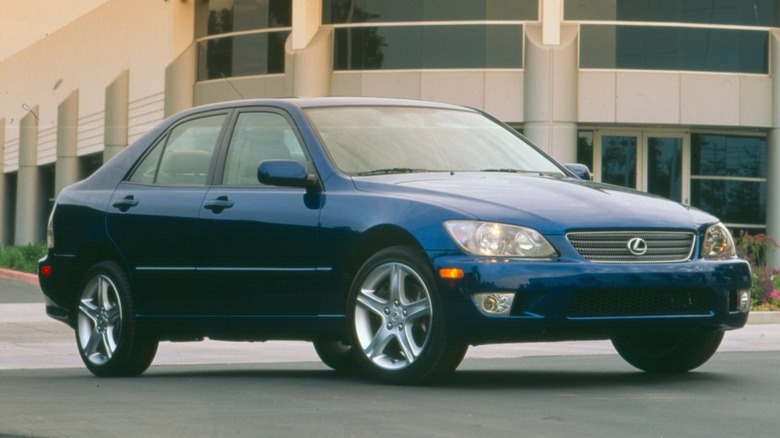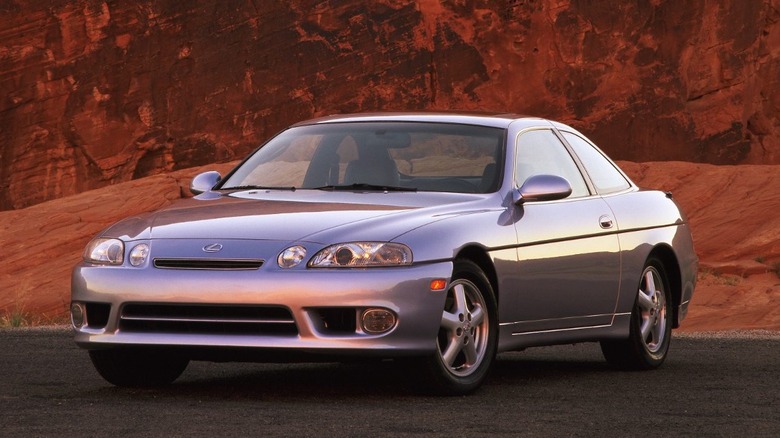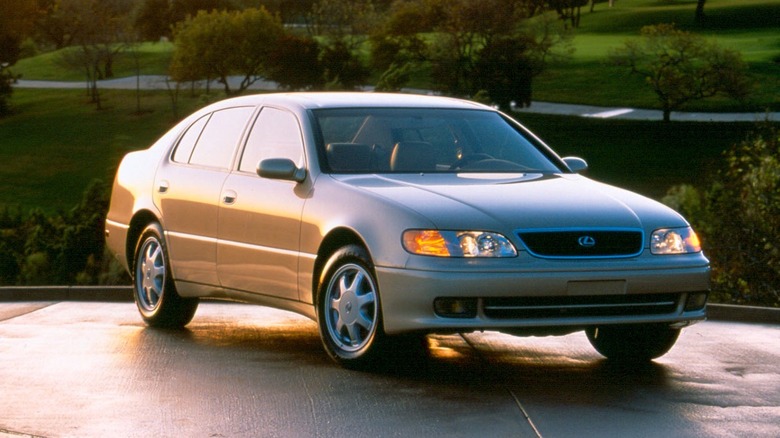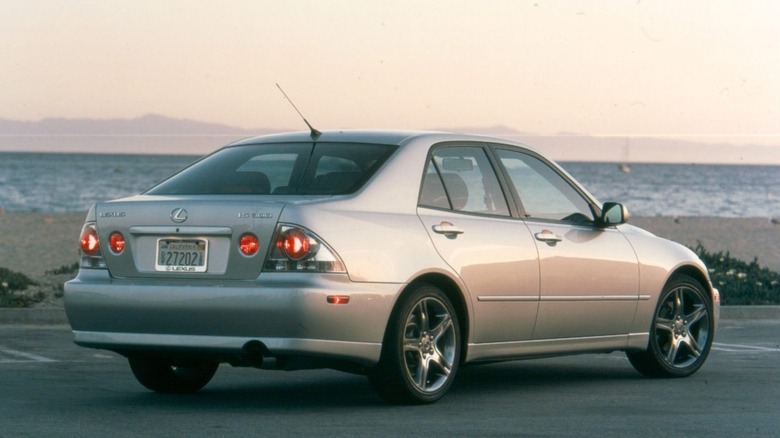Which Lexus Models Have A 2JZ Engine?
Game changers only come around in the automotive industry every so often. In some cases, they come in the form of a disruptive brand, meddling in the endeavors of rivals whose names are synonymous within the markets they dominate. Lexus was one of those troublemakers in the late 1980s and early 1990s, punching up multiple weight classes and KO'ing Mercedes with an opening right hook. The Lexus LS400 redefined the way that the world looked at personal luxury cars, proving that fine leather and walnut accenting were just as opulent in Japan as they were in Germany. As a Toyota subsidiary, Lexus' offerings also came with a promise of reliability and affordability, two areas where the Germans historically struggled.
Engines can be game changers too; the Chevy small-block, Ferrari Colombo V12, and Chrysler HEMI all prove that. Toyota, and by extension Lexus, has a few of its own, but one stands above the rest in terms of its truly seismic cultural impact: the 2JZ. The 3.0-liter inline-six 2JZ shares a legitimate claim to the title of "most notorious Japanese engine ever made" alongside the Nissan RB26DETT, Honda K20, and Mazda's rotary 13B-REW. In the Mk IV Toyota Supra, the twin-turbo 2JZ-GTE gained the reputation of being so over-engineered that it could easily support double its factory horsepower figure via aftermarket tinkering, all without opening the bottom end.
While the twin-turbo 2JZ-GTE is the one that everyone wants, the naturally aspirated 2JZ-GE variant of the engine was also celebrated and found in a larger number of Toyota and Lexus vehicles. Lexus took full advantage of the 2JZ, using it in most of their earlier vehicles including the SC300, GS300, and IS300.
Lexus SC300
Three years after Lexus disrupted German dominance in the luxury sedan market with the release of the LS400 in 1989, eyes remained on the new Japanese manufacturer to see if it would sink or swim. The ES appeared alongside the LS for the 1990 model year and sold well, but the SC luxury performance coupe released in 1991 was Lexus' first truly daring addition. The SC entered the U.S. market as a reworked third-generation JDM Toyota Soarer, which debuted in Japan a month earlier. It put the Mercedes S-Class coupe directly in its sights and offered many of the same luxury accouterments with a lower barrier to entry. Sticking with that mentality, the SC wasn't designed to be a lightweight sports car; it took on a more dignified persona which made it very accessible to casual enthusiasts but alienated die-hard ones.
Just as the notoriously well-behaved 4.0L V8 was a defining feature of the LS400, the powertrain options in the SC took center stage. The SC was initially offered in SC400 trim, which used the same 1UZ-FE V8 found in the LS. The following year, Lexus released the LS300, which featured the vaunted 2JZ engine. Under the hood of the SC300, the 3.0-liter straight-six was found in naturally aspirated form, known internally as the 2JZ-GE. Even lacking the two sequential turbochargers that would later be attached to the 2JZ-GTE in the Toyota Supra, the SC300 was still capable of 225 horsepower and 210 lb-ft of torque. Despite being down on power compared to the SC400, the SC300 was the only variant available with a five-speed manual, making it the more enticing option for buyers who wanted a more engaging driving experience.
Lexus GS300
While the SC300 was a Japan-ified grand touring car, the Lexus GS300, introduced in 1993, was an attempt to go all-out European. The first hint at the GS300's foreign influence was its swift and elegant design, which was penned by one of the best in the business, Giorgetto Giugiaro. While the Lexus GS300 might not have been as striking as some of Giugiaro's other designs, including the DeLorean DMC-12 and BMW M1, its visual presence made it stand out as a particularly handsome model in the Lexus lineup. Again fighting Mercedes and BMW for luxury supremacy, Lexus made sure that interior comfort and attention to detail surpassed expectations. In base form, the GS300's cabin was adorned in velour and accented with genuine walnut trim.
Despite being trimmed to the gills and comfortable on long hauls, the GS300's elegant body shrouded some genuinely sporty underpinnings. To enthusiast delight, the GS300 was rear-wheel drive, featured double wishbone suspension with stiff springs, speed-sensitive steering, and four-wheel ventilated disc brakes. At the heart of the operation was once again the 3.0-liter 2JZ-GE straight-six, which produced 220 horsepower and 210 lb-ft of torque. Unfortunately, the U.S. didn't get the twin-turbocharged 2JZ-GTE that came in the JDM-only Toyota Aristo, the GS300's Japanese twin. The GS300's 2JZ-GE was initially paired with a four-speed automatic before receiving a five-speed auto for its last model year in 1996. While the Lexus GS badge would continue on for another 27 years after the model's 1993 release, its first-gen sales were moderate at best, selling only half the number of units as the flagship LS in its five-year production run.
Lexus IS300
Sticking with the theme of Lexus models targeting German icons, the Lexus IS300 was a direct assault on the BMW 3-Series. Both were developed as luxury-oriented sports sedans, shared similar dimensions, were offered in rear-wheel drive, and featured silky straight-sixes. While the SC300 and GS300 were both sport-adjacent, they were still heavy and floaty. The IS300 slimmed down the formula and shifted it more towards performance. Lexus brought in the big guns to get it done, recruiting Nobuaki Katayama, the chief designer of the Mk IV Toyota Supra, in an attempt to replicate the magic.
Being born into a competitive class of vehicles, the IS300 came prepared. It was decked out with all sorts of performance-oriented hardware. On the chassis and suspension front, the IS300's smaller dimensions put the sports sedan on a 300-pound diet compared to the GS300 and came supported by double control arms at all four wheels. It also came with four-wheel anti-lock disc brakes and an optional limited-slip differential.
The U.S.-spec IS300 even got the premier power plant for once. The Japanese version of the IS300, known as the Toyota Altezza, was released in 1998 and launched with a durable but anemic 207 horsepower 2.0-liter straight-six under the hood. In contrast, the IS300 received a slightly detuned 2JZ-GE, producing 215 horsepower and 218 lb-ft of torque, up 31 ponies compared to the equivalent BMW 325i. Initially, the IS300 was only offered with a five-speed automatic. That changed, to the delight of enthusiasts, in 2002 when a five-speed manual option was added.



